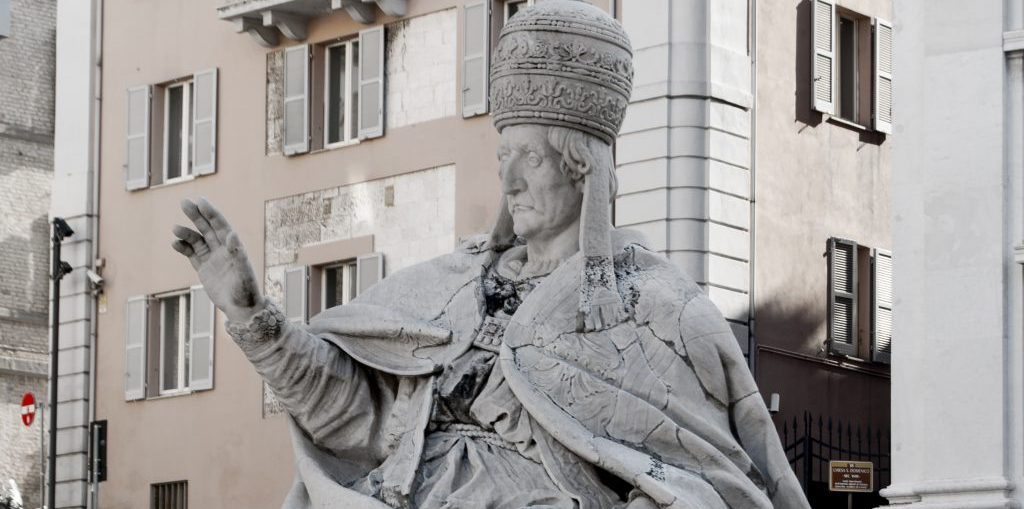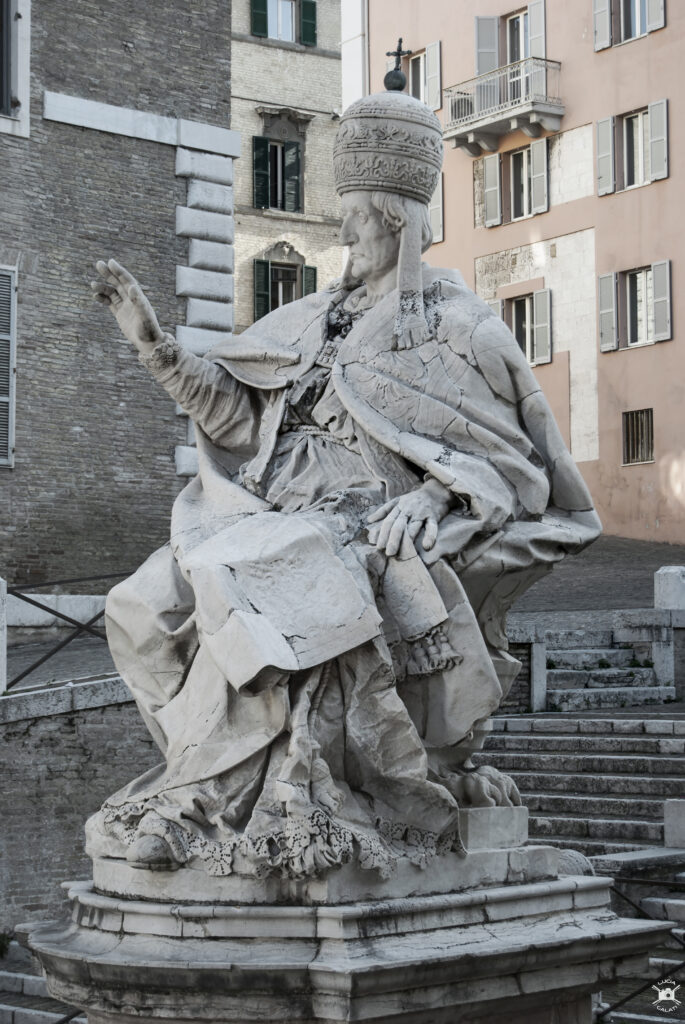
La statua di marmo, donata per interessamento del nipote del papa, Neri o Nereo Corsini, ed opera del berniniano Agostino Cornacchini, fu eretta in ringraziamento della concessione della franchigia portuale che risollevò l’economia cittadina. Clemente XII infatti il 14 febbraio 1732 proclamò Ancona porto franco, sopprimendo tutte le gabelle e i dazi che si solevano pagare e specificava in distinti capitoli “tutti i privilegi ad esso concessi, le esenzioni, le grazie, le franchigie e le libertà solite a godersi da altri simili porti franchi”.
La statua, scolpita a Roma da Agostino Cornacchini, arrivò ad Ancona, via mare, nel febbraio del 1738, condotta sulla tartana del capitano francese Jean Ubanel. Secondo il progetto del Vanvitelli, doveva essere posta sull’attico dell’Arco Clementino, ma, data anche la sospensione nel frattempo intervenuta dei lavori del nuovo molo, si decise la collocazione in Piazza Grande. Posta ai piedi della scalea dell’Incoronata su di un basamento progettato dell’architetto romano Giovanni Battista Bartoli, appartenente all’Ordine dei Carmelitani Scalzi, che disegnò pure la balaustra e restaurò la Fonte di Piazza, la statua era collocata su un alto piedistallo con volute e stemma dei Corsini, al centro di uno spazio cui dava accesso una gradinata ad emiciclo e delimitato da balaustre intervallate da pinnacoli con sfere.
Durante l’occupazione francese fu reso obbligatorio il calendario rivoluzionario, furono aboliti i titoli nobiliari e gli stemmi gentilizi; negli edifici pubblici furono scalpellate le iscrizioni e le insegne dei papi. I giacobini, istigati dai capi del nuovo governo, nella notte tra il 26 e il 27 marzo 1797 si avventarono anche contro la statua di Clemente XII: fu salvata dalla demolizione rimuovendola dal piedistallo e collocandola, entro un recinto di tavole, nel cortile del convento di S. Domenico.
Il 18 dicembre 1818 la statua di papa Corsini, Clemente XII, fu rimossa dal cortile del convento di S. Domenico e riportata in piazza dove fu collocata su un alto piedistallo e ampia scalinata, su disegno di M. Bevilacqua, variandone però l’ubicazione dopo la sistemazione della parte alta della piazza.
Nel 1947 lo scultore anconitano Vittorio Morelli restaurò la statua di papa Clemente XII, danneggiata dai bombardamenti della guerra, rifacendone per intero la testa e parte delle braccia.

piazza del Plebiscito
Statue of Clement XII
The marble statue, donated by the pope’s nephew, Neri or Nereo Corsini, and designed by Agostino Cornacchini of the Bernini school, was erected out of gratitude for the title of free port, that relieved the city’s economy.
Clement XII declared the city a free port on 14 February 1732, abolishing all customs and taxes and making explicit “all the privileges accorded to, the exemptions, graces, and liberties that are enjoyed by similar free ports”.
The statue, sculpted in Rome by Agostino Cornacchini, arrived in Ancona by sea in February 1738, carried on the tartane of the French captain Jean Ubanel. According to the draft by Vanvitelli, it was to be placed on the attic of the arch of Clement, but since the works on the new harbour had been temporarily interrupted, the statue was placed in Piazza Grande (“big square”). It was placed at the foot of the staircase, on a pedestal designed by the Roman architect Giovanni Battista Bartoli, belonging to the Order of the Carmelitani, who also designed the balustrade and restored the fountain. The statue was placed on a high pedestal with scrolls and the crest of the Corsini family, at the center of an area which gave access to a semi-circular staircase with balustrades interspersed with pinnacles with spheres.
During the French occupation, using the revolutionary calendar was mandatory, noble titles and crests were banished; inscriptions dedicated to the popes in public buildings were destroyed. Jacobins, incited by the leaders of the new government, on the night between 26 and 27 March 1797 attacked the statue of Clement XII: the monument was saved from demolition only by removing it from its pedestal and placing it within a wooden fence, inside the courtyard of the convent of St. Domenico. On 18 December 1818 the statue of pope Clement XII was removed from the courtyard of the convent of San Domenico and brought back to the streets and placed on a high pedestal with a wide staircase, designed by M. Bevilacqua. However its location was different from the previous one, because the highest part of the square had been modified in the meantime.
In 1947 the sculptor Vittorio Morelli from Ancona restored the statue of Pope Clement XII, damaged by bombs during the war: the head and part of the arms were completely replaced.
Statua Clemente XII
Piazza del Plebiscito
Statue von Clemens XII
Die Marmor-Statue, wurde vom Neffe des Papstes Neri oder Nereo Corsini gespendet, und von Agostino Cornacchini, im Stil Berninis, behauen. Sie wurde zum Dank für die Anerkennung als Freihafen errichtet, die die Wirtschaft der Stadt angekurbelt hat.
Am 14. Februar 1732 machte Clemens XII. zum Freihafen, und damit war die Stadt zollfrei. Er erklärte “alle anerkannte Vorzüge, Ausnahmen, Begnadigungen und Freiheiten, die ähnlichen Freihäfen gewährt werden”.
Die Statue behaute Agostino Cornacchini in Rom. Im Februar 1738 kam Sie auf die tartane des französischen Kapitäns Jean Ubanel an. Laut dem Entwurf Vanvitellis sollte die Statue auf der Attika des Clemensbogens liegen. Allerdings, da die Arbeiten am neuen Hafen vorläufig unterbrochen wurden, wurde die Statue auf Piazza Grande gestellt. Sie legte an den Füße der Treppe, auf einem Sockel. Der Sockel, sowie die Balustrade, wurden von dem Architekten Giovanni Battista Bartoli, Mitglied des Ordens Carmelitani, entworfen, und der Brunnen restauriert. Der hohe Sockel war mit Windungen und Wappen der Familie Corsini dekoriert. Die Statue legte in der Mitte einer halbkreisförmigen Treppe mit einer Fiale und Kugeln tragenden Balustrade.
Während der Französischen Besatzung war die revolutionäre Kalender verbindlich, und Adelstitel und Wappen wurden abgeschafften; Den Päpsten gewidmete Inschfriften wurden in öffentlichen Gebäuden zerstört. Jakobiner wurden von der neuen Regierung angestiftet und in der Nacht zwischen 26. und 27. März 1797 die Statue von Clemens XII gegriffen. Die Statue musste aus seinem Sockel entfernt werden,und sie wurde endlich innerhalb einem Holzzaun in der Innenhof des Klosters von St. Domenico umgezogen. Am 18. Dezember 1818 wurde die Statue des Papstes w ieder einmal aus dem Kloster auf den Platz über einen hohen Sockel mit einer breite Treppe (Werk von M. Bevilacqua) versetzt. Die Lage war trotzdem anders, weil der höchste Teil des Platzes in der Zwischenzeit geändert war.
Im Jahr 1947 hat der Bildhauer Vittorio Morelli von Ancona, aufgrund der durch Bomben verursachten Schäden die Statue des Papstes restauriert. Der Kopf und ein Teil der Arme wurden vollständig ersetzt.
Statue von Clemens XII.
Piazza del Plebiscito
